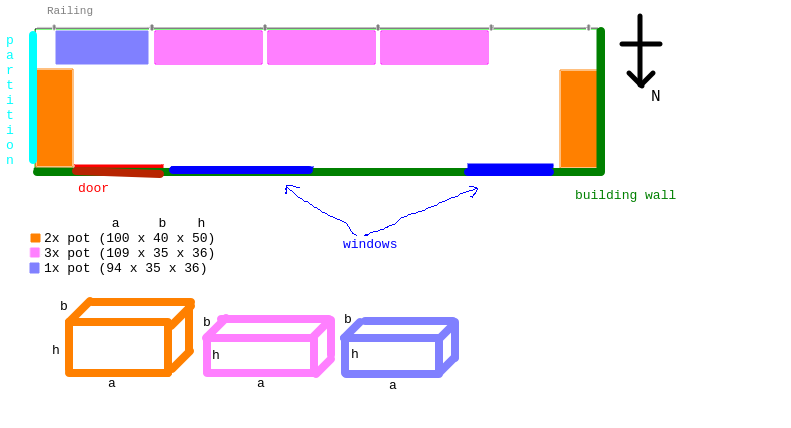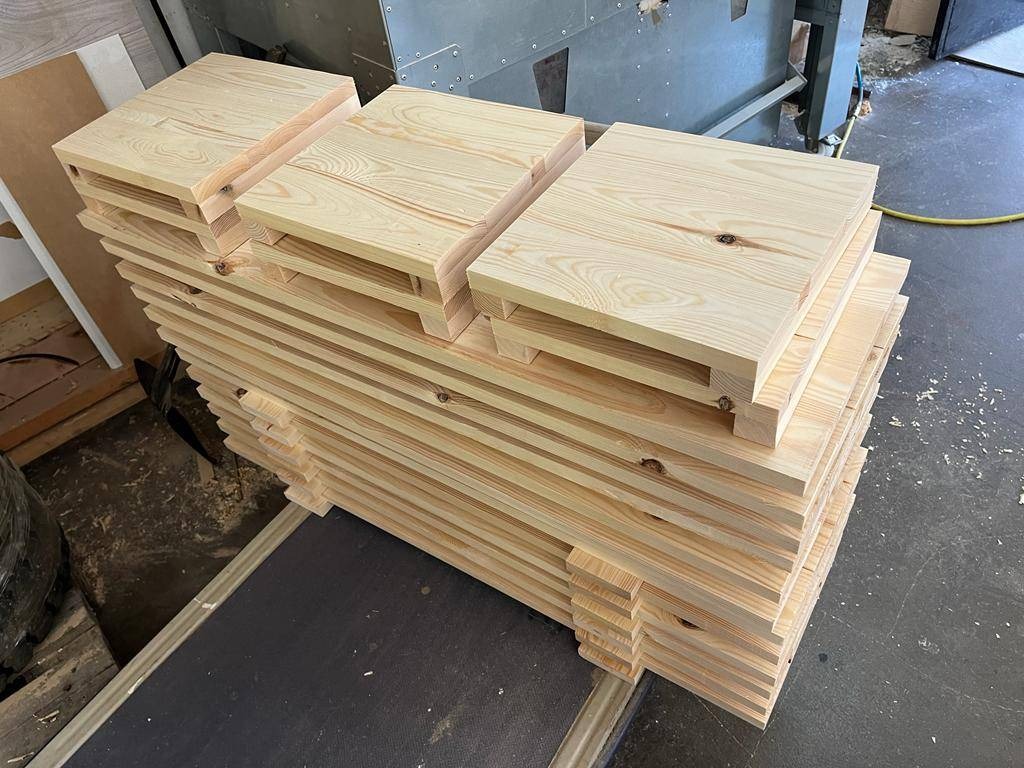Balcony boxes
Plants are pleasant. Growing ones own is good. Problem is that they require light and space to grow. I considered setting up a hydroponics system or - even better - aquaponics, but was informed in no uncertain terms that Not In This Flat. Luckily a large (for a flat), southern facing balcony came to the rescue. So I got me some balcony boxes to plant stuff in.
I find the idea of self-sufficiency very alluring, so I want to be able to grow as much of my own veg as possible. That means multiple large boxes. Luckily I know someone who sometimes works as a carpenter, so I got him to make me proper wooden boxes, which I’d then simply screw together. I settled on the following plan, with an extra 3, 16cm heigh boxes to go above the 3 pink ones. So 9 boxes in total:

This will provide some 1.1 m3 of volume (including the box walls), and 3.42 m2 of planting space. Which is quite decent for a balcony.
The problem with having big boxes on a balcony is weight. Soil is heavy. Water also. Wood too. So I had to do some calculations to work out whether I can proceed or not - apparently the balcony is designed for a max of 200kg / m^2. I assume that this is more of a recommended value that is provided to customers, rather than a real physical limit - 2 people per square meter is not a lot - but it seems like a good idea to keep the weight down as far as possible.
First off the boxes. They are made of pine, which has a density of 352-859 kg/m3, according to this site, which was the first I found. That’s good enough, as I mainly care about the max expected weight, not the precise value of the finished boxes. The screws can be ignored, as they all together weigh less than 1kg. I actually weighed a couple of boxes - the largest ones were a bit under 20kg, while the pink ones around 15kg, which give a density of around 550 kg/m3.
Next the soil. This is the tricky bit. Basic soil has a bulk density (i.e. after being dried out) of 1000 to 2000 kg/m3 (according to this, this or this). Which is quite concerning - even using the lower bounds of 1000 kg/m3, that’s going to result in ~300 kg/m2. Which is 1.5 times more than allowed. And that’s just bulk weight - adding water will add another 200-300 kg/m3. So basic soil is out.
How about compost, or peat? Peat appears to have a density between 200-400 kg/m3. Which is a lot better. But peat isn’t renewable, and is being over extracted, so I’d prefer not.
It’s surprisingly hard to find data on compost density. But I found a couple of papers which suggest a bulk density of around 400-600 kg/m3. I also had a look for compost weight, thinking that your average gardener is more likely to consider weight than density. This gives an even larger margin - some suggest a dry weight of ~250 kg/m3 while here it’s provided as ~500 kg/m3 (or ~900 kg/m3 when wet). I’m interested in max weight, so lets go with 900 kg/m3, which gives 263 kg/m3 after dividing by the total area to be used. That’s still too much.
Plants need a medium for their roots, to keep them stable etc. At least when they’re exposed to the elements. They also need said medium to have nutrients. But it doesn’t have to be soil - hydroponic systems work fine with just water and nutrients. That won’t work here though, because the roots need to keep the plants in place. But hydroponics is also often done with various other stuff which then gets watered with nutrient rich water. How about doing something like that here? But rather than liquid food, just mixing in very nutrient rich compost with something that is inert, but very light? That should then approximate a normal soil, but at a fraction of the weight. The 3 most common such substances are LECA, perlite and vermiculite, with densities of respectively ~400 kg/m3, ~100 kg/m3 and ~90 kg/m3 (for coarse vermiculite). This is very encouraging, especially as mixes of ~30-40% filler are encouraged. The nice thing about these substances is that perlite causes potting mixes to drain better, while vermiculite is very good for water retention, sucking up extra water and then releasing it to the plants when the soil starts to dry out. Both of these characteristics are valuable (for different plants, of course). So this would allow me to both greatly lighten the soil, and also have different types of soil. Perfect!
Just to be sure, I created a calculator to work out how much things will weigh:
Box dimensions:
Densities:
Results
Pics!
This is what the boxes looked like before being put together:

Here they are in all their glory (plus other random rubbish…):

This is what the double boxes will look like when I get round to screwing them together, once I get enough soil for it to make sense:
